Banjima and Malkana Country
My life living and working in Exmouth was 10 years later a distant memory, but on the recent return drive from the Kimberley, my love of the red dust landscapes of the Pilbara and Gascoyne Regions was reinvigorated. It was time to return….
The plan for the week was to drive the Great Northern Highway to Karijini NP where Lorenz and I had booked four nights at Karijini Eco-retreat. Our return journey to Perth would be via the North West Coastal Highway with a two night stopover at Shark Bay.
We left a wet Perth very early on the morning of Saturday 4th May. North of Perth near Bindoon the sun rose turning the clouds in the East of the sky pink. Twelve hours later while we were still on the road, the sun set as we approached the mining town of Newman, it was a long day of driving!
I had pre-conceived ideas that the towns we would drive through would be best passed through quickly, but on the contrary the towns of Mt Magnet, Cue and Meekatharra would have definitely warranted exploration had time allowed.
Reptiles were in short supply during the drive as expected in the cooler month of May but we saw many, many Wedge-tailed Eagles over the course of the day. It seems the Great Northern Highway and it’s road kill are a magnet for these magnificent raptors.
Sadly a number had become road kill themselves, probably unable to take flight in time with a belly full of meat. As road users we all have an obligation to pull any wildlife we inadvertently hit well off the road in order to prevent the death of further wildlife, such as raptors and monitor lizards. Although I suspect the main suspects are road trains, for whom it is impractical to clean up road kill.
We overnighted at the excellent accommodation at the Newman Visitor Centre. Not only was the accommodation modern but it was immaculately clean and reasonably priced. Highly recommend. We arrived after dark and when we woke in the morning we could see were surrounded by retired mining machinery! What an excellent idea.
Waking up amongst monsters at Newman Visitor Centre.

North of Newman the landscape changed almost immediately from the previous day, instead of flat landscapes, the terrain changed to mountains of iron ore, welcome to the Pilbara! A further two hours driving and we arrived at Karijini NP.
At the park entrance, we discovered a notice informing us that Weano and Hancock Gorges was closed from that day for urgent road repairs. Unfortunately, it remained closed for the duration of our stay.
I had previously visited Karijini 10 years ago, and the only two gorges I hadn’t visited were Weano and Hancock! These things happen despite the best of planning, and there was nothing to do but take it on the chin and make the most of the gorges that we were able to visit, fortunately of which there were still plenty.
The day was predicted to reach a warm 32C, so we stopped at Dales Gorge for a swim en route to our accommodation. The carpark was almost full at Dales, and when we descended into the gorge there were plenty of folk enjoying a dip at Fortescue Falls.
Fortescue Falls.

We made our way to nearby Fern Pool, and it was as beautiful as I had remembered it. There is a ladder to assist entering the water, once in the waters at first felt cool, but the body soon acclimatised. There is a waterfall at the far end of the large pool and it is possible to climb behind the falling water to a fern and moss lined grotto beneath the falls. Magical!
Fern Pool (Dales Gorge.)

When I had first visited Dales Gorge in 2008 there had been a Flying-fox colony roosting in the paperbarks near Fern Pool, but on the walk in I had not heard the usual noise of a colony, so I wondered perhaps if this was not the case anymore.
After our swim, I searched the treetops on the walk back to Fortescue Falls and lo and behold there were around forty Black Flying Foxes hanging silently from the branches. These animals must have been fast asleep in the midday heat, hence the unusual quiet, so I planned a return visit early morning when greater activity was assured.
The road to Dales Gorge is sealed, but Banjima Drive that traverses the National Park to the Eco-retreat is unsealed. During my last visit it was extremely corrugated but fortunately this time it was like a dream, probably having been recently graded at the end of cyclone season.
One of my favourite vistas in Western Australia is from Karijini’s Banjima Drive. Looking across the savannah, if it wasn’t for the red dirt and spinifex, it is possible to imagine the African plains are in front stretching to the horizon.
Savannah views from Banjima Drive.
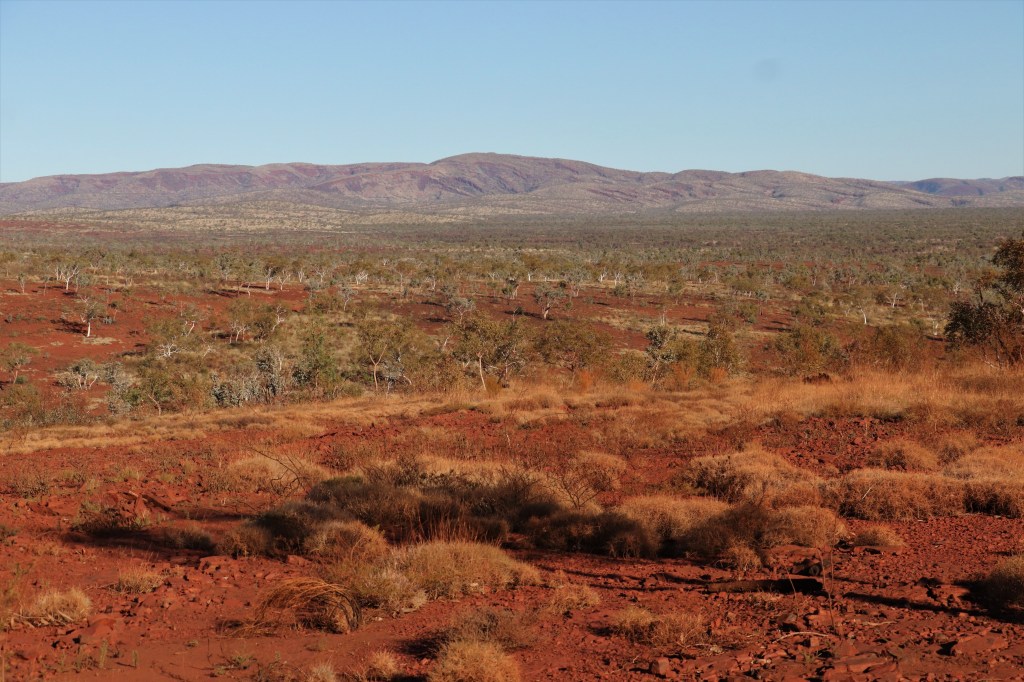
The accommodation at the Eco-retreat was comfortable but a little basic and definitely not worth the price, although the setting is magical on the savannah and only a fifteen minute walk from Joffre Gorge.
Karijini Eco-retreat Tent.

It was to Joffre Gorge that we headed at sunset, climbing down into the gorge to view Joffre Falls from the amphitheatre like basin at the bottom. Despite the falls being dry it was a wonderful place to spend time as dusk fell.
Joffre Falls.

The following morning was Lorenz’s 37th birthday so I left him to sleep in while I made an early morning drive to Dales Gorge. I had the place to myself at sunrise and the Flying-foxes were vocal and active at this time of the day.
Back Flying-fox.

Later in the day I returned to Dales Gorge with Lorenz and we walked the Dales Gorge Walk. We parked the car and descended into the gorge from Threeways Lookout first visiting the tranquil Circular Pool surrounded by a pocket of verdant rainforest.
Circular Pool.
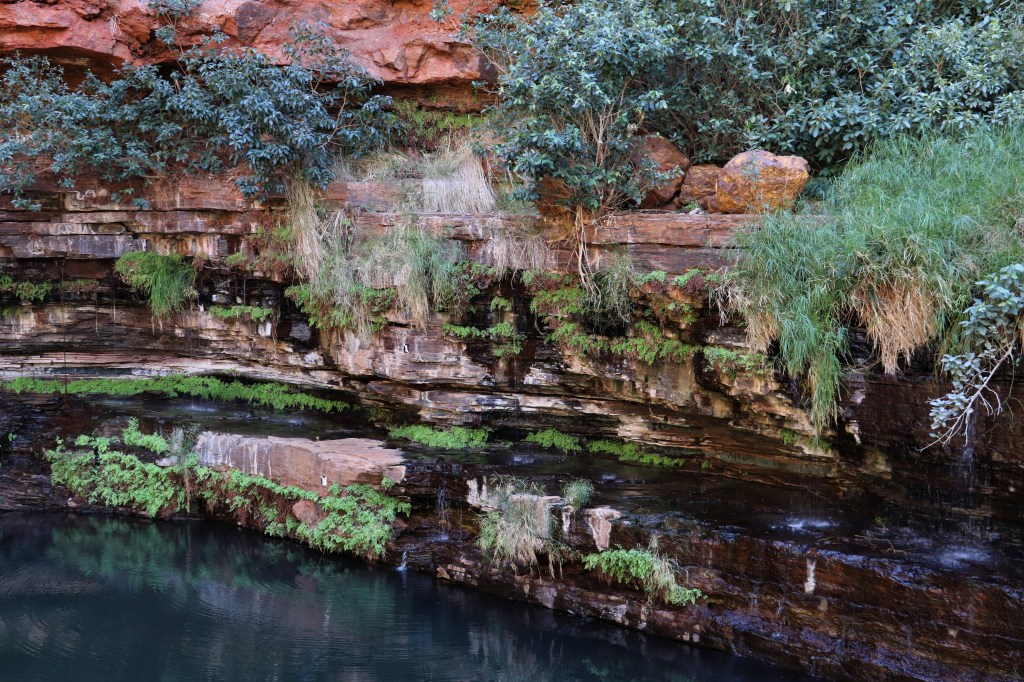
The walk along the gorge floor took about an hour on what was a warm day, so we were definitely ready for a swim by the time we had reached Fortescue Falls. Plenty of people had the same idea, and the water was cool and refreshing. Along the walk there was plenty to look at with fig tree roots draped along the rocks of the gorge and red dragonflies flitting from rock to rock.
Fig Tree Roots.

Red Dragonfly.
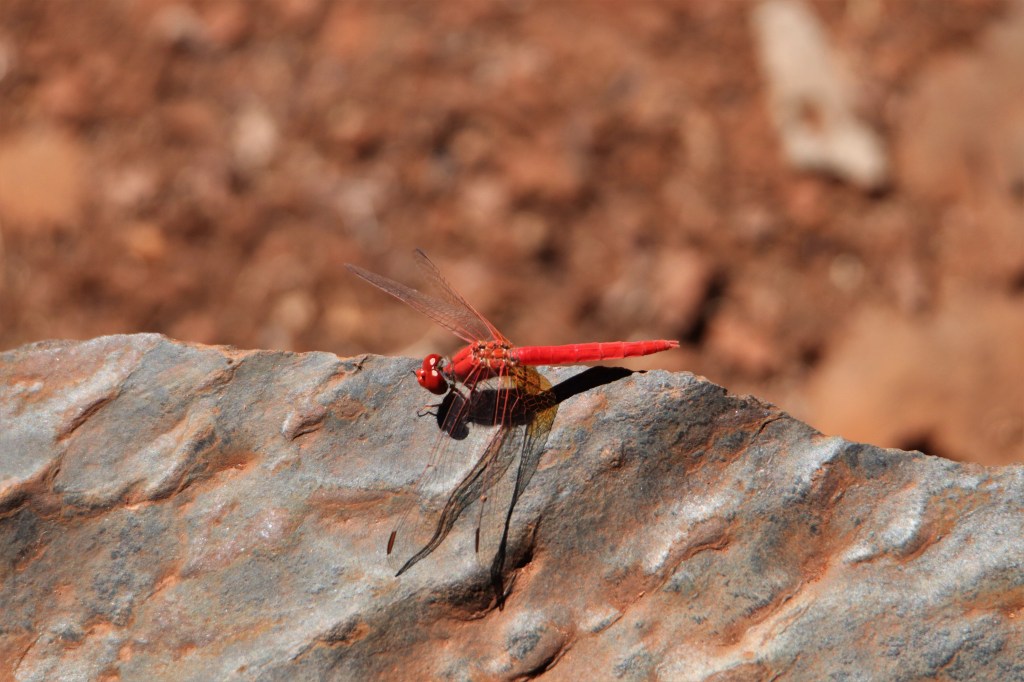
Refreshed from out swim we returned to the Eco-retreat for a lazy afternoon because in the morning we were to climb Western Australia’s second highest mountain Punurrunha also known as Mount Bruce.
The alarm was set for 4am and boy was it cold outside the tent. To get from the Eco-retreat to the start of the summit trail for Mt Bruce we followed Banjima Drive to the Western entrance to the park, then almost immediately opposite over Karijini Drive is Mount Bruce Road.
We encountered a Dingo on the road soon after leaving the Eco-retreat, this animal had an obvious injury and was clearly limping, but otherwise looked in healthy condition as it hobbled off into the night.
We were the first car in the carpark that morning, which was great, because I had read of people seeing Rothschild Rock Wallabies on this walk and if we were the first walkers we would hopefully find this species undisturbed by other walkers. As we set off it was just possible to see the outline of the mountain ahead of us from the light of the stars.
Mount Bruce. The Summit Trail Follows Ridge from Right of Picture.

The walk ascends from the carpark and then follows a ridge of lesser hills and peaks before ascending Mount Bruce itself. There were view points along the trail looking South over the Marandoo Mine Site but of course it was till dark at this time, although as we walked the black horizon to the East rose to midnight blue, deep orange then pink as dawn began to break. As we had climbed we had seen a light following us along the trail behind and knew that we would soon have company.
Map showing location of carpark at base of Mount Bruce Trail.
The trail then climbs Chinaman’s Hat via a series of switchbacks, and it was at this point in the half light that we took a wrong turn and ended up on a scree slope.
My instinct told me we had lost the path, but I thought I would ascend the scree slope to see if I could relocate the path from the top, then, at the top of the scree slope adjacent to a sheer rock face, I encountered a Rothschild Rock Wallaby! I don’t know who was more surprised myself or the Wallaby! It hopped off to base of the rock face and considered me before propping nicely on a rock for a picture.
Alas, the light was not yet good enough for a picture, but hey all I had to do was wait a couple of minutes for the light to improve. Unfortunately at this exact moment, the hiker that had been behind us also took the same wrong turn, and when he saw us he also ascended the scree slope. I had to communicate to him that we had taken a wrong turn, further disturbing the Wallaby in the process, which hopped up on another ledge and began browsing on a shrub eventually disappearing.
Lorenz and I both had views of the Rothschild that had actually lasted a couple of minutes and the purple sheen on the back of the neck was clearly visible. The Rothschild Rock Wallaby is the largest of Australia’s Rock Wallabies which made me think that the petite individual we saw must have been a sub-adult. I was delighted to finally see a Rothschild after dipping in the previous year at Karratha, but the photo of this species remains elusive.
We retraced our steps and regained the track for the vertical scrabble up the side of Chinaman’s Hat, definitely not a part of the walk for the faint hearted! The traverse across Chinaman’s Hat and the ridge that connected to Mount Bruce proper was the best part of the walk.
Looking back from Chinaman’s Hat along the series of hills the trail traverses.
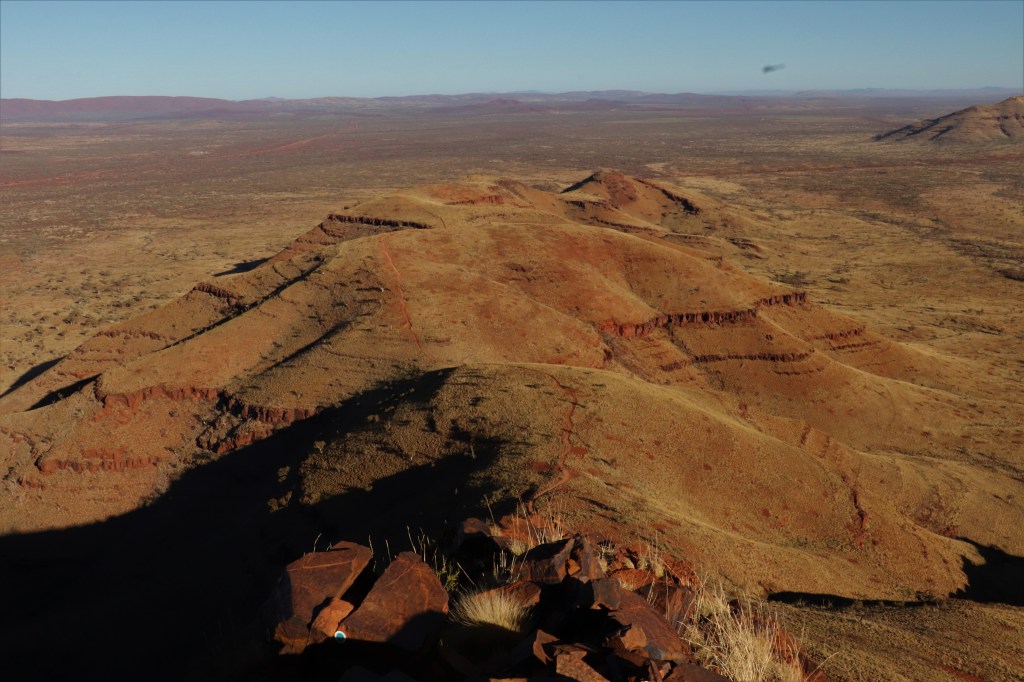
The final ascent of Mt Bruce was via a series of switchbacks through dense bush and was a bit dull, but before long an impressive cairn appears on the horizon, the top of WA’s second highest mountain.
The views from the top are excellent in all directions to the other mountains of the Hammersley Range which surround Mt Bruce.
The Cairn signalling the summit of Mount Bruce.

After some photos and a brief rest we returned the way we had come. The trail length is 9km and had taken us four hours in total. The Mount Bruce Summit Trail is surely one of the best walks in the whole of WA and I would highly recommend it if visiting Karijini.
That afternoon while Lorenz enjoyed a well deserved rest I set off to explore nearby Knox Gorge. The road to Knox Gorge passes by the lookout over Joffre Falls so I made a brief stop to check out the falls from the viewpoint.
Joffre Falls.

The Knox Gorge carpark was a few kilometres further along from Joffre Lookout and the road was quite rough in places. The path down into Knox Gorge was the most difficult descent into a gorge in the park, it was very steep and at times the descent was on loose shale, but once at the bottom it was like being in another world.
There was an azure blue pool surrounded by lush vegetation and the sound of birdcall echoed along the riparian vegetation. A stream from the pool meandered down the gorge and the path followed alongside the stream.
As I walked along the gorge I was lucky to see a large Monitor lizard sunning on the flat rocks of the gorge floor, a beautiful Gould’s Monitor.
Gould’s Monitor in Knox Gorge.

The Gould’s was clearly intent on making the most of the Autumn sun and wasn’t worried about my presence or indeed the presence of any of the other walkers that passed close by. The Gould’s Monitor is the most widely spread of the WA monitor lizards and occurs from the Kimberley at the top of the state down to the Southern Wheatbelt. ( It is replaced in the far South by the Southern Heath Monitor.)
Gould’s Sand Monitor.

The path becomes trickier as it goes on skirting rock ledges over water and involving water crossings, but the scenery is breathtaking with massive jagged red gorge walls towering above, eventually a sign is reached indicating it is too dangerous to proceed and at this point I felt like I was in the bowels of the earth.
On the return journey I encountered a Collared Sparrowhawk perched in a tree with an eye out for dinner. It didn’t seem to mind my presence as I photographed it although it must have been warm sitting in the sun because after a while it flew down to the creek to drink where I was able to further observe it.
Collared Sparrowhawk.

Hammersley Gorge was the destination for our last day at Karijini. The 86km drive is firstly via sealed Banjima Drive, then via the unsealed Hammersley – Mount Bruce Road, and Nanutarra – Wittenoom Roads, although these unsealed roads were in excellent condition.
The effort it took to get to Hammersley Gorge was more than rewarded by the gorge itself. The gorge walls consist of a kaleidoscope of colours and are buckled into the most fantastic shapes.
Hammersley Gorge.

There are a series of excellent swimming holes along the gorge, the most enchanting of which is Spa Pool, a small, deep pool fed by its own waterfall. Lorenz and I couldn’t wait to get in!
Spa Pool – Hammersley Gorge.
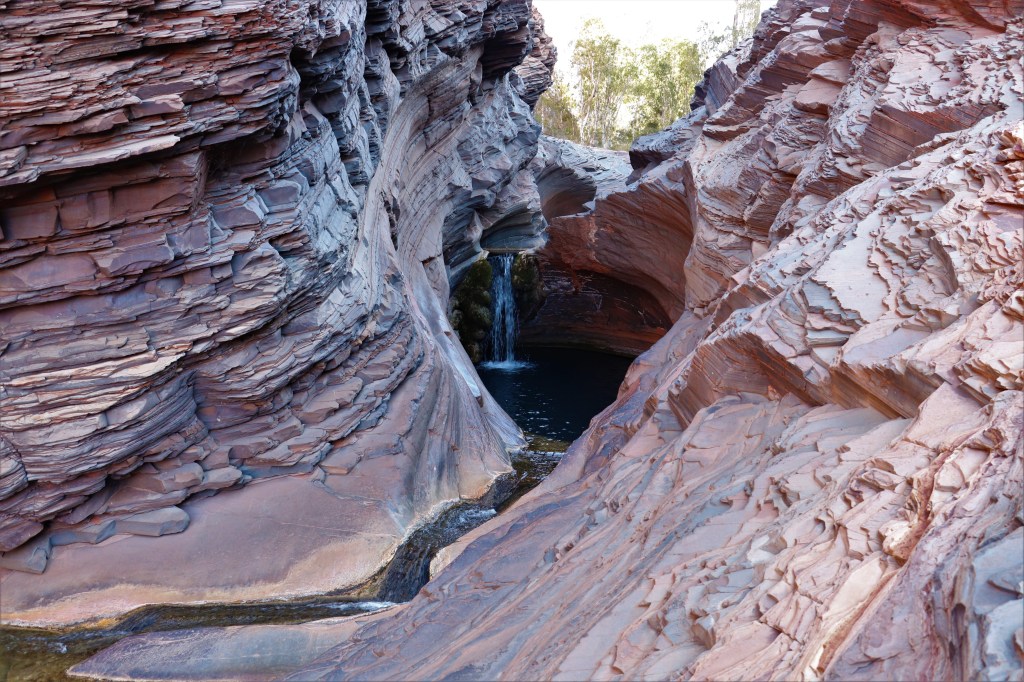
The afternoon was spent between lazing on the warm rocks and swimming in the cool but pleasant waters. The drive back was magnificent as the afternoon sun lit up the Hammersley Range. We watched sunset from the Joffre Gorge Lookout and marvelled at the many colours of the evening sky.
Snappy Gum at Dusk.

That evening Lorenz and I celebrated his recent birthday with a slap up meal at the Eco-retreat. Where the Eco-retreat lacks in accommodation it makes up for with its excellent restaurant. It was early to bed for the morning was to be another long day on the road.
Thursday was a day I’d rather forget. We set off at 8am and drove all day to Overlander Roadhouse via Nanutarra and Carnarvon. South of Carnarvon there is a serious goat problem (one only had to look at the denuded vegetation to see it,) and as the light was failing I had to contend with numerous goats crossing the highway. We overnighted at Overlander as planned, to drive further would have been madness.
The following morning after a complementary breakfast at the roadhouse we drove the ninety minutes up the Peron Peninsula to Denham. There are numerous attractions and view points along the drive to break it up. We stopped at the Stromatolites because it’s not everyday you can see the oldest, living fossils on the planet!
Stromatolites.

There was a cold Easterly blowing and so we were glad to return to the car and continue the drive. We also stopped at Shell Beach, a beach made entirely of little white shells, and also Eagle Bluff on our drive up the peninsula. Emu’s were plentiful on the peninsula but were a little flighty.
Our last stop was at the fabulous Ocean Park Aquarium just outside of Denham. This excellent attraction has a continuously running tour of the exhibits and contains some great specimens. The highlight at the aquarium is undoubtedly the shark tank, containing many different species of large sharks with boardwalks over the tank.
Ocean Park Aquarium.
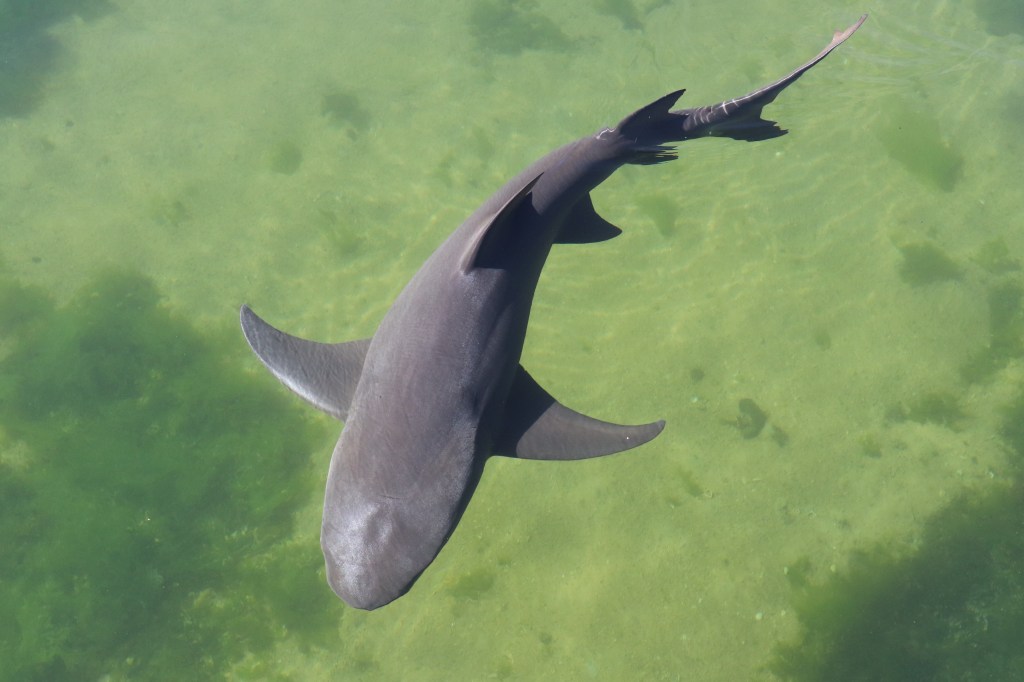
Our accommodation at Denham was the excellent Shark Bay Seafront Apartments right on the waterfront. I had previously twice visited Denham and I love the fact that it is such a sleepy little place, although these days it is noticeably busier than 10 years ago. It is Australia’s most Westerly town and situated facing the setting sun.
Sleepy Denham.

After we had unpacked we made the short drive up the peninsula to Peron Homestead. This former stock station has been preserved as it was as a working station including stockyards and an outdoor hot tub supplied by artesian bore water.
On the drive up we encountered a spiky Shark Bay local crossing the road, although a little shy at first, it soon continued on its way enabling a few pics.
Echidna.
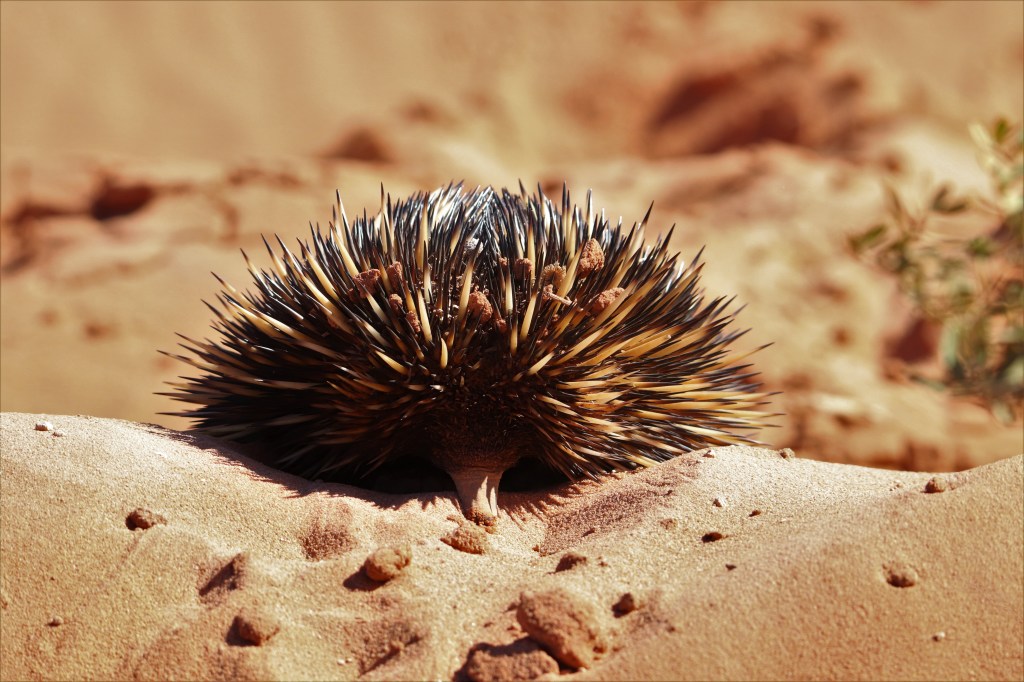
The following day we made the drive up to Cape Peron at the top on the Peron Peninsula. This is a sandy 4WD track (very sandy in places!) and tyre pressure needs to be reduced accordingly. For this purpose there is an air pump located just past the homestead.
The Orange Sands of Cape Peron.
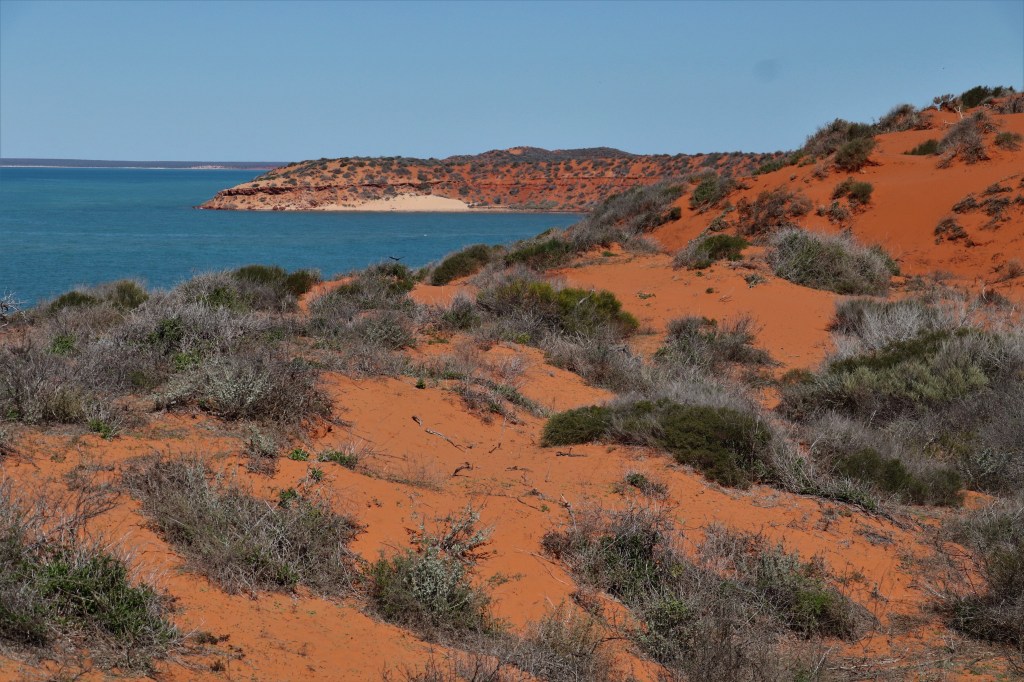
On the return journey we encountered another Echidna in almost exactly the same location as the previous day, again crossing the road but this time in the opposite direction. Late afternoon we went out for a wildlife drive but we didn’t even need to leave the town to see wildlife. The first wildlife we encountered were Wallaroos that had come in from the bush to feed in the gardens of properties on the outskirts of town.
Common Wallaroo or Euro.

We then encountered two Emus wandering down the middle of the industrial estate, but unlike the nervous Emu’s of the previous day this pair were as cool as cucumbers and not shy of the camera!
Emu.

Lorenz and I had dinner at the Old Pearler Restaurant in town, an enchanting building made entirely from shells with a great ambience and great food also. We capped off the night with a soak at the hot tub at Peron Homestead. What an amazing West Australian experience sitting in a hot tub under the stars in the Australian desert.
The following day we made the return journey to Perth, starting early in the morning when there were lots of Spinifex Hopping Mice on the roads leaving Denham pre-dawn. Otherwise it was an uneventful drive back to the West Australian Capital. The trip had been excellent and I hope to return soon to the beautiful landscapes of the Pilbara…..
#QuollingAround
I love the photos Jimmy!
And such a good read!
LikeLike